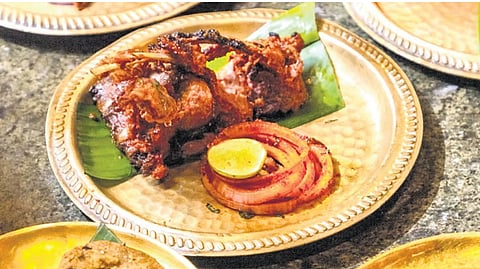Ramzan via GT Road
Everyone has their way of paying tribute to people they hold in high regard. For MasterChef India 2016 finalist Sadaf Hussain, 35, his ode to the founder of the Sur Empire, Sher Shah Suri, is through the kitchen with a special menu, ‘Mandi Se Mez Tak’, for this Ramzan. The items on the menu at the GT Road restaurant are inspired by the culinary legacy of Sher Shah’s Grand Trunk (GT) Road.
“Growing up in Ranchi, my go-to place every summer was my grandparents’ home in Sasaram, the place where Sher Shah is buried. Every year, during the summers, we would go to the tomb complex and have a picnic there on its grounds,” says chef Hussain. His love for food grew when he learned about Sher Shah’s contribution to trade through the GT Road, which allowed many new culinary delights to cross borders and spread through the Indian subcontinent.
GT Road’s Inns and kitchens
Trade has been part of the Indian subcontinent since its earliest civilisation of Harappa. With different empires, various trade routes emerged. A highway called Uttarpatha, which was supposed to have connected the stretch extending from the mouth of the Ganga in the east (in present-day Bangladesh) to Taxila (Gandhara) and Balkh (Bactria), in present-day Afghanistan, in the north-west, was built in 3rd century BCE during Chandragupta Maurya’s reign. The route, however, eventually fell into neglect until the 16th century when Sher Shah initiated its repair by way of building his own highway aligned to the old one. Under his rule, the new highway came to be known as ‘Shah-Rah-e-Azam’ (The Great Road), a 2,600-km stretch from Kabul to Sonargaon (in what is now Bangladesh).
Sher Shah increased the road’s width, constructed inns and caravanserais where traders and travellers were provided with food and shelter for free. The same route was used by the Mughals. Under colonial rule, this road was refurbished and metalled through its stretch from Calcutta to Delhi to Kabul, and has since been known as the GT Road on which Afghan traders travelled to reach the far eastern reaches of Bengal.
Spice markets
Till today, Kabuliwalas, dried-fruit merchants from Afghanistan in Kolkata, can be encountered on the city’s streets. Their presence not only introduced dried fruits to the subcontinent but also influenced its literature. Rabindranath Tagore’s short story ‘Kabuliwala’ is inspired by these merchants who travelled the road to Kolkata for trade — Hussain’s favourite tale is, however, Rudyard Kipling’s Kim, full of the bustling markets that dotted the GT Road. Hussain says that Delhi’s spice market is still set up like it was in Sher Shah’s time. “Back then shops were not named, but numbered, because traders were itinerant. This tradition continues in Khari Baoli’s markets today, though it is now a hub of mostly settled traders.” Alongside dried fruits and spices, the western end of the GT Road also introduced kebabs and naan, he adds.
Meet the Bihari kebab
Hussain has now curated a menu that reflects the flavours of iconic stops along the road. One of the highlights is the Bihari Kebab, also featured in Hussain’s book Daastan-e-Dastarkhan (Hachette India, 2019). “For the Bihari Kebab, we use a thin slice of papaya, with a thin slice of meat. And instead of besan, as binding agent, we use a sattu mixture,” he explains. These kebabs, as the name suggests, travelled with Sher Shah from Bihar to the north-western regions of the subcontinent and gained popularity after his rebellion against the Mughals in 1538.
Another unique kebab is the Gular Kebab. The term ‘gular’ means fig in Hindi; however, figs are not among the ingredients. Instead, the name derives from the kebab’s fig-like shape. This Awadhi special holds sentimental value for the chef as his mother used to cook it. It has a blend of sweet — this comes from dried fruits — and spicy flavours. To replicate the fig’s grainy texture, the chef uses poppy seeds, which is unusual for kebabs. Made from mutton and stuffed with dried fruits and poppy seeds, this kebab is given an egg wash. It is meant to be broken from the middle, allowing one to experience the blend of flavours all at once.
For vegetarians, there are dal kebabs. “I cook gosht (meat), but people love my dal kebabs,” says Hussain. The simple Miya Ji Ki Daal, a lentil soup from Lahore with tempering, is also a must-try.
The menu offers a variety of dishes from starters, main course, and chaat corner to desserts, from around the GT Road. The main course includes Qorma — a Turkish dish that made its way to the subcontinent through Mughal cuisine, Mirchi Keema — a Chagatai-origin minced meat dish, and Posto Maach — a Bengali speciality. Another interesting dish is the Kaleji Tawa Katakat, where “katakat” refers to the sound made when the meat is mixed with spices on a tawa.
“Food tells stories,” says Hussain. Through this menu, he aims to share the stories behind the names, cooking methods, and traditions associated with each dish, inviting diners to immerse themselves in a mix of anecdotal tales, rich history, and amazing food.
Meal for two: Rs 2,400 + taxes (approx), at ‘Mandi se Mez Tak’ buffet till April 12 at GT Road restaurant, Connaught Place. Timings: 12pm-4.30 pm for lunch and 7pm-12 am for dinner

